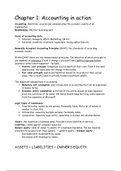Summary
IBEB Accounting Summary (English). Grade: 8
- Module
- Institution
- Book
Comprehensive summary for Accounting, includes all content from the book and the lectures. This summary enabled me to get one of the highest grades in the year (top 10%). Uitgebreide samenvatting voor Accounting aan de Erasmus Universiteit.
[Show more]




